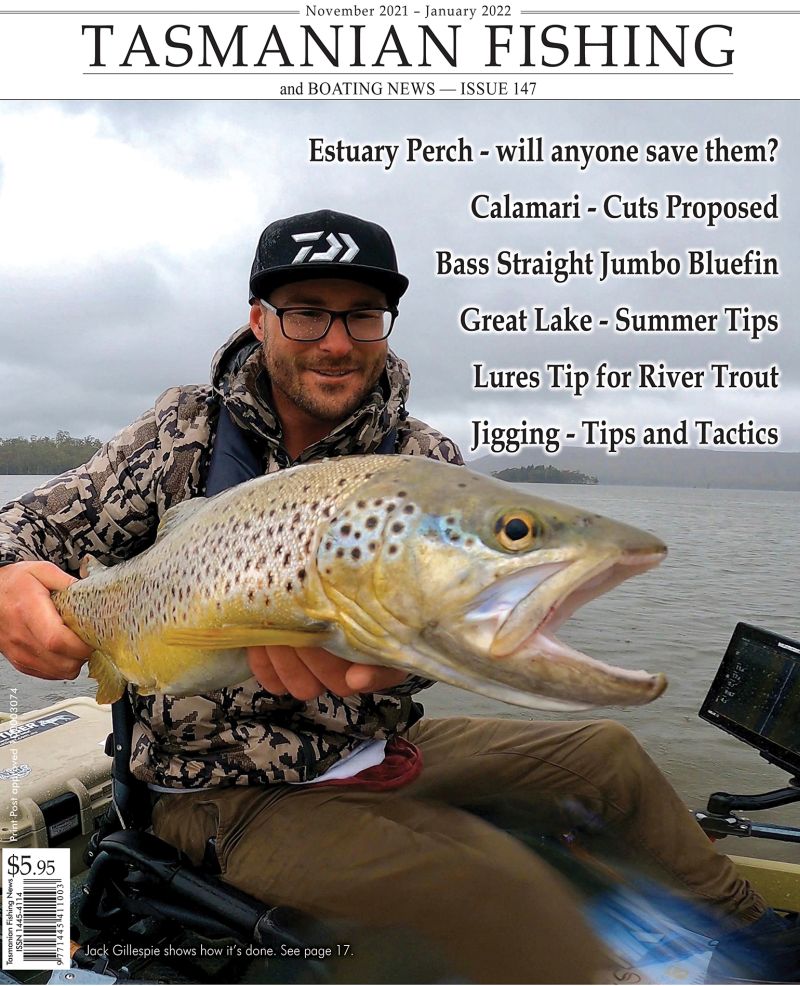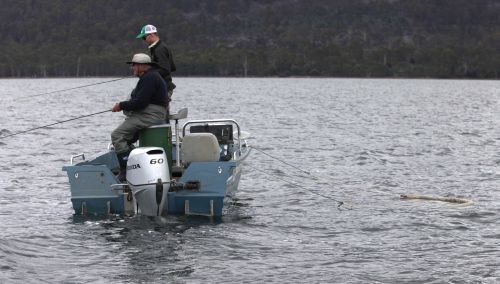From the Archives ...
Atlantic salmon the hard way
Atlantic salmon the hard way
Scott McDonald
The first Atlantic salmon eggs used to begin Tasmania's Atlantic salmon aquaculture industry were introduced into Tasmania in 1984. From these humble beginnings a valuable Tasmanian industry has evolved with a worldwide reputation for having a premium disease free product. This industry provides a spin off to all anglers in the form of regular escapes of salmon from the farms.
Drogues Slow down and catch more fish.
History
When I first started guiding 13 seasons ago our business was entirely lake based. The highland lakes of Tasmania are well know for windy personas. The wiser,more experienced local anglers all used drogues to slow their boats so I purchased the biggest drogue I could find. It was the conventional windsock type of design and was a flouro yellow colour.
- Category: Tackle, Boats and other Equipment
- Hits: 8134
Soft Plastics, Getting Started Towards Success (Part 1)
Introduction
Soft plastic fishing lures what are they?...What are the benefits of using them?... What setup do I need to fish them?...How do I rig and retrieve them?...What lure or technique should I use on this species or that species?...etc etc.
Well these are just some of the many questions anglers regularly ask in relation to the use of soft plastic fishing lures. This article is the first in a series of articles that are intended to take you through the step by step process of becoming a successful soft plastics angler.
- Category: Tackle, Boats and other Equipment
- Hits: 11768
Read more: Soft Plastics, Getting Started Towards Success (Part 1)
The Joys of Boating
The following story is true. Phil from Blessington has given permission to use this story - of several parts, as long as his true name is not revealed. It has previously appeared in the journal of the Victorian Fly Fishers Association.
- Category: Tackle, Boats and other Equipment
- Hits: 9592
Mega Multi Tool Review
Back in the old days everybody's Grandpa had a favourite pocketknife. Times change however and the pocketknife has been replaced by the multi-tool, a hybrid of the Swiss Army knife and the humble plier! Here is the latest and greatest in multi-tools for those thinking of a Christmas present, or just another toy.
- Category: Tackle, Boats and other Equipment
- Hits: 8001
Unlocking the secrets of soft plastics
Part 2: Tips and HintsLast issue, Steve Starling reveled some of the secrets of success when using the newest generation of soft plastic or rubber lures that are taking the country by storm. This time, Steve presents some very useful tips on selecting and using these deadly lures in our local waters.
- Category: Tackle, Boats and other Equipment
- Hits: 12995
Read more: Unlocking the secrets of soft plastics Part 2: Tips and Hints
Unlocking the secrets of soft plastics
Part 1: The BasicsSoft plastic of rubber lures are taking the country by storm, but many anglers are still not getting the best from these lures. In this ground-breaking of how-to feature, soft plastics" whiz, Steve Starling, reveals the secrets of success, with a special emphasis on Victorian waters.
- Category: Tackle, Boats and other Equipment
- Hits: 11865
Southern Bluefin Lures
As many of Tasmania's saltwater game anglers await the annual southern bluefin tuna "run', lure choice is usually the prime topic for discussion. With the past two years being particularly good, anglers are waiting in anticipation for the next few weeks - will Tasmania be blessed with a "hat trick" of productive tuna seasons?
- Category: Tackle, Boats and other Equipment
- Hits: 11517
Propellors getting it right
Propellors can make the difference a great boat with a good performance and economy and a dog of a boat. Rick Huckstepp explains how you can get the best from your boat.
The "in" word in the new boat sales industry has for the past five years, been, "packages'.
A package allows one to walk into a showroom or yard and purchase a complete unit, hitch it onto the vehicle and go fishing. Sounds easy, doesn't it?
- Category: Tackle, Boats and other Equipment
- Hits: 7001
Rocky's Six Best Game Fishing Lures
Mike Stevens interviewed Rocky Carosi on his 35" charter boat Saltshaker. These are his six top lures and ones he recommends to Tasmanian gamefishers. Rocky runs professional charters out of St Helens and for bookings can be contacted on 63 763 083.
- Category: Tackle, Boats and other Equipment
- Hits: 7663
Downrigger fishing
Downrigger fishing is a method almost exclusively associated with trolling at depth. In depths of water from 1 - 200 metres a separate braided stainless steel wire line and weight take your bait or lure to your desired depth. When a fish hits your bait, your line is released and you fight the fish on your rod and reel, with no heavy line or weight to battle. Downrigging while trolling is without doubt the most accurate way of presenting a lure or bait at depth, but there is no reason why this technique can't be employed for other fishing methods.
- Category: Tackle, Boats and other Equipment
- Hits: 10718
Current TFBN
Click above for current issue content. The current issue of TFBN is extensive and topical. In Tackle Stores, Newsagents and by subscription.
Delivered to your door for $48 for 2 years (8 issues). To subscribe, send Mike $48 via www.paypal.com.au . (Basic instructions are here) The email is at Contact Us. Your address will be included from PayPal.
Or phone Mike with your c/c handy on 0418129949
Please ensure your details are correct, for Mike to organise delivery.
TFBN Newsletter Sign up Form
Why not submit an article ?
When you have finished for the day, why not have a brag about the ones that didn't get away! Send Mike an article on your fishing (Click here for contact details), and we'll get it published here. Have fun fishing - tasfish.com
Category Descriptions
Here is a list of all of the Article Categories. The number in Brackets, eg (13) is the number of articles. Click on Derwent River and all articles relating to the Derwent will be displayed in the central area.
Articles by Category
-
Rivers (3)
-
Saltwater and Estuary Fishing (149)
-
Kayak Fishing (34)
-
Lakes (1)
-
Great Lake (62)
-
Lake Leake (52)
-
Woods Lake (16)
-
Lake Augusta (11)
-
Huntsman Lake (13)
-
Lake Pedder and Gordon (10)
-
Lake Dulverton (5)
-
Lake Crescent (6)
-
Tooms Lake (10)
-
Lake Mackintosh (2)
-
Lake Barrington (5)
-
Little Lake (8)
-
Meadowbank Lake (5)
-
Lake King William (7)
-
Lake St Clair (2)
-
Western Lakes (12)
-
Arthurs Lake (35)
-
Lake Echo (7)
-
Four Springs (54)
-
Lake Sorell (7)
-
Lake Burbury (6)
-
Other Lakes (57)
-
Brushy Lagoon (18)
-
Little Pine Lagoon (5)
-
Penstock Lagoon (16)
-
Brumbys Creek (7)
-
-
Events (48)
-
Estuary Fishing (0)
-
Coastal Catches (46)
-
Super Trawler (46)
-
IFS, DPIPWE, MAST and Peak Bodies (435)
-
Commercial Interests (98)
-
Other (24)
-
TFBN Back Issues (8)
-
Fly Fishing (67)
-
Trout Fishing (252)
-
Meteorology and Weather (8)
-
Jan’s Flies (50)
-
Tuna Fishing and other Game Fishing (86)
-
Cooking Fish (19)
-
Fishing Information (1)
-
Fishing Books (8)
-
Videos (5)
-
Tackle, Boats and other Equipment (146)
-
World Fly Fishing Championship 2019 (2)
Popular Tags
windyty.com
Visit https://www.windyty.com/
Rubicon Web and Technology Training
Hello everyone, I thought it would be a good time to introduce myself.
My name is Stephen Smith and I have been managing the website tasfish.com since May 2009.
It has been an epic journey of learning and discovery and I am indebted to Mike Stevens for his help, support and patience.
I am developing a new venture Rubicon Web and Technology Training ( www.rwtt.com.au ). The focus is two part, to develop websites for individuals and small business and to train people to effectively use technology in their everyday lives.
Please contact me via www.rwtt.com.au/contact-me/ for further information - Stephen Smith.
From the Archives ... (last chance)
Sea runners - Early Season Excitement - Christopher Bassano
Presented from Issue 100
Considering the world class quality of our sea trout fishery, these fish are not sought after by enough anglers. Sea runners live in the salt water and run up our estuaries and rivers from the start of August to the middle of November. At this time of the year, they are here to eat the many species of fish that are either running up the rivers to spawn or are living in and around the estuary systems. Trout, both sea run and resident (Slob Trout) feed heavily on these small fish which darken in colouration as they move further into fresh water reaches.
The majority of these predatory fish are brown trout with rainbows making up a very small percentage of the catch. They can be found all around the state but it would be fair to say that the east coast is the least prolific of all the areas. They still run up such rivers as the Georges (and many others) but their numbers along with the quality of the fishing elsewhere make it difficult to recommend the area above the larger northern, southern and western rivers.
Read more ...


